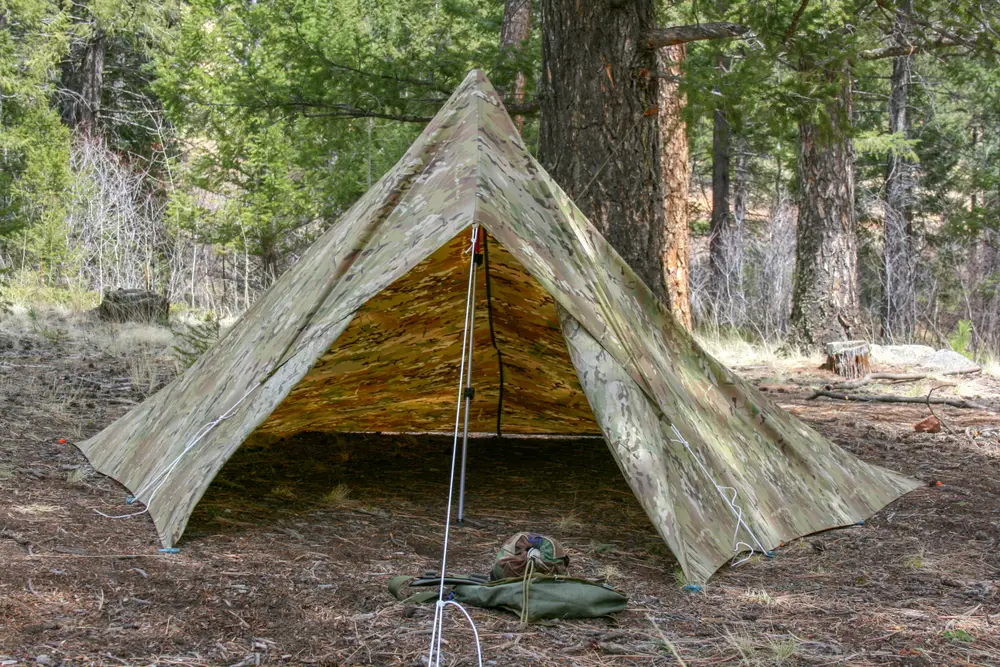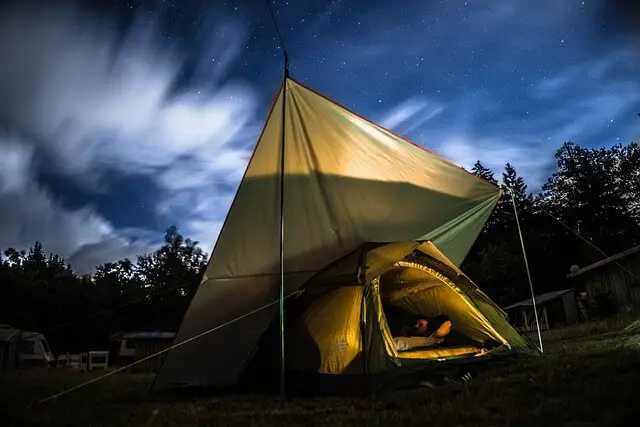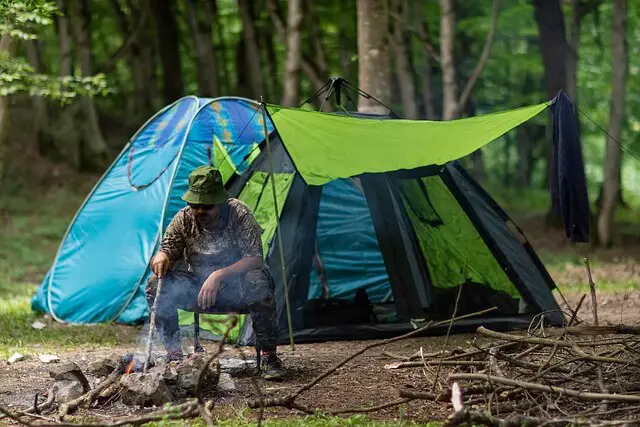If you ever do find yourself in a survival situation, or you have gone camping with nothing but a tarp, expecting to find trees to help you put it up, then you might be a little bit stuck.
If you have a tarp, and no trees to aid you in creating your shelter, then you are going to need to improvise and fast.
A shelter is your best friend when it comes to camping out in the wild, and without one, you are going to be opening yourself up to many different threats.

There are so many different things that are against you in the wild, like harsh weather conditions, nearby wildlife, and even insects. The last thing that you want is to be left out in the open having to brace these elements without the safety of a shelter.
How to Make a Tarp Shelter Without Trees? - There Are A Few Ways
Thankfully for you, there are a few ways that you can make a tarp shelter without the help of any nearby trees. We are going to talk you through the best way to make a tarp shelter without any trees, so you can be prepared for any situation.

What Tarp Should I Use?
The first and most obvious thing that you are going to need to think about is the type of tarp that you are using. It needs to be strong, durable, and waterproof in order to be effective in this type of situation.
One of the best types of tarp that you can use in this type of situation is a polyethylene tarp. This is one of the best types of materials for shelter-building due to the fact that it is completely waterproof, which is one of the most important features for your tarp to have.
One of your highest priorities will be keeping warm and dry, and this is definitely the material for the job.
Another great thing about this tarp is that it is really lightweight, which makes it much easier to carry with you when you are on the go. This also means that you will be able to carry much more stuff with you than you would have been able to with a heavy and bulky tarp that weighs you down.
This type of tarp is also tear-resistant, which is a great feature for any shelter materials to have. When you are using the natural environment and materials that nature has provided you with, accidents can happen, and the last thing you need is to tear a huge hole in your tarp. This would just make it ineffective.
Another thing that you should know about this type of tarp material is that it is naturally mildew resistant as well as waterproof. Any tarp that is in a warm and dark place is susceptible to mildew, which can work to ruin your shelter.
Thankfully, polyethylene tarp does not have this problem as it is much more difficult to damage through mildew.
A-Frame Shelter
One of the most common and most popular tarp shelters that you can make is the A-frame shelter, and this is because it is really easy to put up and you can do so in a short amount of time if you need to.
To make this shelter, you are going to need some sturdy sticks, a good amount of paracord, some stakes, and bungee cables.
The first thing that you are going to need to do is to secure the sticks that you are going to be using. You need to make sure that these sticks are not rotting, and that they are thick and sturdy enough to hold your shelter together.
A-Frame Shelter - Setup
You should measure the length of the tarp, and put the sticks around a foot outside of this measurement. You need to secure the sticks into the ground, and the height will determine how tall your shelter will be. Sometimes, you need to sacrifice height for stability.
Next, you will need to get out your handy paracord and run it around so that you have enough slack. Make sure that it is not too slack, as this will cause your tent to sag, which you don’t want to happen. You might find that you need to readjust your poles, and that is fine.
The next step would be to hang your tarp over the top so that it hangs evenly on both sides, and make sure that it is a good shape. Now, all that is left to do is to secure everything in place. You will need to use your stakes to anchor down the tarp.
Finally, all you need to do now is to secure the tarp in place further by using your bungee cables. You should test your shelter to make sure that it is going to hold up through the night, and then you are good to go.
Try moving it gently from side to side, and if it doesn’t budge, then you can be sure it will stay up. Make sure that it is fully secured to the ground to avoid it blowing away while you are asleep.

Basic Fly Roof Shelter
This is another simple and easy shelter that you can make using a tarp, though it might not always be the most effective in all situations.
To make this shelter, you will not need any nearby trees, but you will need some long sticks or branches to help build the structure.
So, while it is a simple shelter, you will need to work to find the right sticks to use for your structure. They need to be sturdy enough not to snap under the pressure of your shelter, especially if rain were to gather on top of it. You are going to need four guy lines, four stakes, and four good and long sticks.
Basic Fly Roof Shelter - Setup
All you have to do to make this shelter is to place your four sticks into the ground to make the four corners of the square, and then place your tarp on top to create the roof.
Once you have done this, you will need to secure everything in place using your stakes and guy ropes, which will help to keep the tarp on top.
Use one rope and stake to secure every corner, and your shelter is ready to use. This type of shelter is great for providing you with shelter from the sun, but not so great for when it is really windy or raining.
- Are Merrell Shoes Good? – An Unbiased Review of Merrell Footwear - December 9, 2023
- Where Are Merrell Shoes Made? - December 9, 2023
- Camping in 40-degree Weather: Tips and Tricks - September 25, 2023

![How to Inflate an Air Bed without a Pump? [Most Effective Ways] How to Inflate an Air Bed without a Pump? [Most Effective Ways]](https://grandcircletrails.com/wp-content/uploads/2022/07/How-to-Inflate-an-Air-Bed-without-a-Pump-150x150.jpg)
![How to Get Burrs Out of Clothes? [Most Effective Ways] How to Get Burrs Out of Clothes? [Most Effective Ways]](https://grandcircletrails.com/wp-content/uploads/2022/06/How-to-Get-Burrs-Out-of-Clothes-150x150.jpg)
![Is Camping Safe or Dangerous? [Few Simple Safety Tips] Is Camping Safe or Dangerous? [Few Simple Safety Tips]](https://grandcircletrails.com/wp-content/uploads/2022/05/Is-Camping-Safe-or-Dangerous-150x150.jpg)
![How to Stop Condensation in Tent? [3 Effective Methods] How to Stop Condensation in Tent? [3 Effective Methods]](https://grandcircletrails.com/wp-content/uploads/2022/06/How-to-Stop-Condensation-in-Tent-150x150.jpg)

